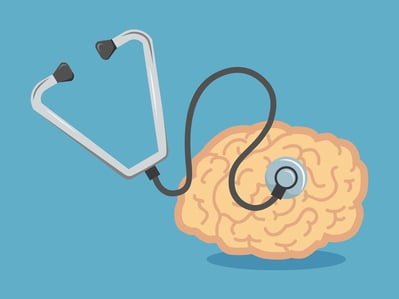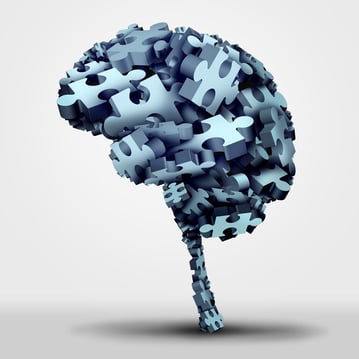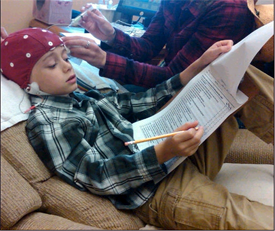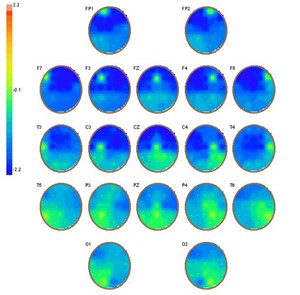Brain Map
The Quantitative Analysis of Digital EEG data, or Electrical Brain Waves
Once we know where the brain is having trouble, treatment protocol can then be developed to target those specific brain waves during neurofeedback sessions. The data is recorded at 19 locations on the scalp and is stored in a computer for the neurofeedback specialist to later analyze.
When we analyze this data, we are looking at a number of EEG factors including EEG brain wave size or magnitude, EEG brain wave frequency, and coordination or connectivity between brain locations. The information from this analysis is then used to develop a neurotherapy treatment protocol unique to the individual.
Most people are seeking to function more effectively in demanding states such as learning, remembering, reading, solving math problems, processing social information, interacting with others, etc. Therefore, data is recorded in various neurological states such as eyes closed, eyes open, reading, and performing other age appropriate tasks.
The size of brain waves in particular locations can tell so much about the functioning of the brain.
If brain waves are too large, it is an indication of insufficient engagement in that area, an inattentive brain in particular locations. This can also be related to what is called a lack of cortical controls. This happens in people with impulsivity and other behavior problems as well as in people with problems with executive functions. Someone with hyperactivity can actually have this kind of brain, and, in fact, most people with ADHD or ADD symptoms have large brain waves in certain locations, particularly in the front of the brain.
The front of the brain, or the frontal lobes, is a very important part of the brain. The frontal lobes are like the cockpit of an airplane or the conductor of an orchestra; they run the show.
If the brain waves are too large in the frontal lobes, there can be problems regulating mood, regulating impulsivity, switching from one state to another, switching from one task to another, getting started with tasks, or doing tasks independently.
There may be problems with memory, planning, organizing, and completing tasks as the person has trouble monitoring their individual state. They are unaware if they are behaving appropriately or doing a task correctly. Individuals with frontal lobe dysfunction may have temper tantrums or explosive behavior. Because all of these are all considered executive functions, the issues here are control, planning, and cause and effect thinking.
Large brain waves throughout the brain can be related to developmental delays, autism, depression, or slow processing. Large brain waves along the midline of the brain can be related to anxiety, attention, compulsive behaviors, obsessive thoughts, or irritability.
Large brain waves in the middle of the brain in the area going across the top of the head from ear to ear can impair attention and be related to problems with hyperactivity. There may be problems with coordination or sensory integration with sensory seeking or ultra physical sensitivity.
 If these brain waves are large on the left, they may be related to problems related to language, speech, or reading. If they are on the right, they may be an indication of anxiety.
If these brain waves are large on the left, they may be related to problems related to language, speech, or reading. If they are on the right, they may be an indication of anxiety.
Many functions related to vision are located in the back of the brain. Large brain waves and brain waves that are larger on one side of the back of the brain than the other, called asymmetrical brain waves, can be an indication of vision problems.
Brain waves can also be too small, which means that area is overactive. If this occurs in the front part of the brain, this may be related to anxiety, obsessive-compulsive disorder, post traumatic stress disorder, or sleep problems. In these cases, we teach the brain to make these brain waves larger.
Asymmetrical brain waves in the temporal areas above the ears can be a sign of auditory processing challenges. There is a location in the back right side of the brain that is thought to be related to processing social cues such as reading facial expressions. When brain waves are too large in this location, the person tends to have difficulty in social situations, something we call social competence. When the brain waves are too small in that location the person may be over reading social cues such as reading into people’s facial expressions. This may lead to anxiety and oversensitivity to rejection.
As you can see, anxiety can appear in a lot of different ways in the brain. Everyone’s brain is different. For example, anxiety may present itself with different types of brain wave activity in different people. This is why a brain map is so important in determining treatment protocol.
It's important to know in what locations the brain is having trouble functioning so we can teach these locations to be more effective.
trouble functioning so we can teach these locations to be more effective.
Even more important than the size of the brain wave is the measure of coordination across the brain, called comodulation. The pattern of comodulation is an important factor we take into consideration when treatment protocol is developed, because it helps us decide which sites to treat simultaneously in a way that will either increase or decrease their coordination with one another.
Comodulation maps indicate abnormal brain function, showing which locations are working well together and which locations are not. When locations are not functioning well with each other, this is referred to as hypo-comodulation. Alternately, some locations may be doing too much of the same, telling us that there is not sufficient differentiation between locations, called hyper-comodulation


